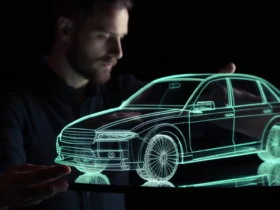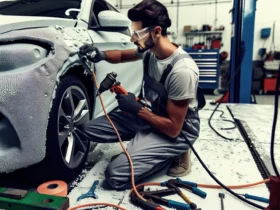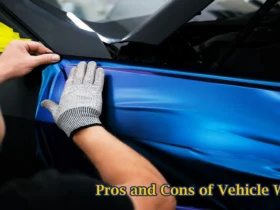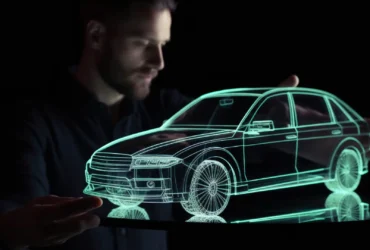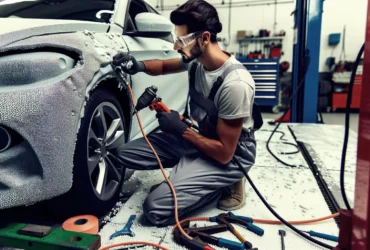When it comes to driving an SUV, understanding the essential SUV safety features is crucial for every driver. From airbags and seatbelts to blind spot detection and lane departure warning, these features play a significant role in ensuring the safety of both the driver and passengers. We will delve into the top SUV safety features that every driver should be well-informed about. Let’s explore how these features work to enhance the overall safety of SUVs on the road.
What are SUV key features?
SUVs are known for their blend of utility, performance, and safety features that cater to a wide range of needs. Key features that are common and sought after in SUVs include spacious interiors that can accommodate passengers and cargo comfortably, all-wheel or four-wheel drive options for enhanced traction and off-road capability, and advanced safety features. Modern SUVs, such as the 2024 Hyundai Tucson, 2024 Ford Mustang Mach-E, and2024 Mazda CX-30, come equipped with technologies like rearview cameras, blind-spot monitoring, automatic emergency braking, and lane-keep assist. Additionally, infotainment systems with smartphone integration, adaptive cruise control, and energy-efficient powertrains are increasingly popular in SUVs.
Common Safety Features in SUVs
Just when it comes to prioritizing safety on the road, SUVs are equipped with some of the most advanced safety features available. Here are some of the SUV safety features every driver should know about:
- Airbags and Seatbelts: All modern SUVs come with front airbags, and many also include side-curtain airbags for additional protection. Seatbelt pre-tensioners are also common, which automatically tighten the seatbelt upon impact to reduce the risk of injury.
- Anti-lock Braking System (ABS): This feature prevents the wheels from locking up during emergency braking, allowing the driver to maintain steering control. ABS is a standard feature in most SUV models.
- Electronic Stability Control (ESC): ESC helps prevent skidding and loss of control by automatically applying brakes to individual wheels and reducing engine power when necessary.
- Blind Spot Detection: Many SUVs are equipped with sensors to detect vehicles in the driver’s blind spot, providing a visual or audible alert to help prevent potential collisions.
- Lane Departure Warning: This feature alerts the driver when the vehicle begins to drift out of its lane without the use of a turn signal, promoting safer driving habits.
- Automatic Emergency Braking (AEB): AEB systems detect potential collisions with vehicles or pedestrians and apply the brakes if the driver fails to do so, reducing the severity of accidents or avoiding them altogether.
- Adaptive Cruise Control: This feature maintains a set speed and distance from the vehicle ahead, automatically adjusting the speed to keep a safe following distance.
- Rearview Camera: A standard feature in most new SUVs, the rearview camera enhances visibility when reversing, reducing the risk of accidents, particularly in crowded or busy areas.
With these advanced safety features, SUVs are designed to prioritize the well-being of both drivers and passengers, making them a reliable choice for families and individuals looking for a secure driving experience.
Airbags and Seatbelts
When it comes to suv safety features, airbags and seatbelts are at the forefront of accident prevention and passenger protection. Here’s what you need to know about these critical safety components:
- Airbags: SUVs are equipped with advanced airbag systems that include front airbags, side airbags, and side curtain airbags. These airbags are designed to deploy in the event of a collision, providing a cushioning effect to reduce the impact on occupants. The presence of multiple airbags in SUVs enhances protection from various angles, minimizing the risk of serious injury during accidents.
- Seatbelts: Seatbelts are the primary safety system in any vehicle, including SUVs. They work in conjunction with airbags to secure occupants in place during a crash. Modern SUVs are equipped with advanced seatbelt technologies such as pretensioners and force limiters, which work to tighten the seatbelt and then gradually release the tension in a controlled manner, reducing the risk of chest and upper body injuries.
In comparison, while both airbags and seatbelts are crucial for occupant safety in SUVs, it is important to note that airbags provide additional protection by cushioning the impact from different directions, while seatbelts primarily secure occupants in place during a crash.
Remember, proper usage of seatbelts and understanding the function of airbags is vital for maximizing safety in SUVs.
Anti-lock Braking System (ABS)
SUV safety features, the Anti-lock Braking System (ABS) stands out as a crucial component. This system is designed to prevent the wheels from locking up during braking, thereby maintaining traction with the road surface. Here are some key points to consider about SUV safety features and ABS:
- Prevents Skidding: ABS helps to prevent skidding and loss of control, especially in slippery or emergency braking situations.
- Enhanced Steering Control: By preventing wheel lock-up, ABS allows the driver to maintain steering control while braking, which is particularly beneficial in avoiding collisions.
- Shorter Stopping Distances: As ABS prevents the wheels from locking, it can significantly reduce the stopping distance, potentially preventing rear-end collisions.
- Comparison: When comparing SUV models, look for those with advanced ABS technology that offers quicker response times and improved effectiveness in varying road conditions.
In conclusion, the Anti-lock Braking System (ABS) in SUVs plays a critical role in enhancing driver and passenger safety. When considering different SUV models, a well-functioning ABS should be a top priority for potential buyers looking to prioritize suv safety features.
Electronic Stability Control (ESC)
When it comes to SUV safety features, Electronic Stability Control (ESC) plays a crucial role in ensuring a secure driving experience. This advanced technology is designed to improve a vehicle’s stability by detecting and reducing skids. Here’s why ESC is a game-changer for SUV safety:
- Prevents skidding: ESC intervenes by applying brakes to individual wheels, helping to prevent the vehicle from skidding or sliding out of control, especially on slippery or uneven road surfaces.
- Enhances steering control: By assisting the driver in maintaining control during emergency maneuvers, ESC significantly reduces the risk of accidents caused by oversteering or understeering.
- Improves traction: SUVs equipped with ESC have better traction on challenging road conditions, such as icy or wet surfaces, providing an added layer of safety for drivers and passengers.
In a comparison of SUV safety features, vehicles with ESC demonstrate a remarkable capability to maintain stability and prevent hazardous skidding, making it an essential feature for modern SUVs. When considering a new SUV, prioritizing Electronic Stability Control (ESC) can significantly elevate your driving safety.
Blind Spot Detection
Blind spot detection is one of the crucial suv safety features that can significantly enhance the driver’s awareness on the road. This advanced technology utilizes sensors to monitor the vehicle’s blind spots and alert the driver of any potential hazards. Here are some key points to consider about blind spot detection:
- Monitoring System: The blind spot detection system constantly monitors the adjacent lanes to detect any vehicles or obstacles that may be out of the driver’s line of sight.
- Visual and Audio Alerts: Upon sensing a vehicle in the blind spot, the system will typically alert the driver through visual cues such as a warning light in the side mirrors, and sometimes with an audible warning.
- Enhanced Safety: By providing timely warnings, blind spot detection helps prevent accidents caused by lane-changing maneuvers. This feature is particularly valuable during highway driving and heavy traffic conditions.
- Complement to Rearview Camera: When used in combination with a rearview camera, blind spot detection offers comprehensive assistance for safer lane changes and overall driving awareness.
In summary, blind spot detection is a valuable suv safety feature that acts as an extra set of eyes for drivers, making lane changes and highway driving safer and more secure.
Lane Departure Warning
SUV safety features, the Lane Departure Warning system is a crucial addition that enhances driver alertness and reduces the risk of accidents. This advanced feature uses cameras or sensors to monitor the vehicle’s position within the lane. If the system detects any unintentional lane drifting without the use of a turn signal, it will alert the driver through visual, auditory, or haptic feedback.
How Lane Departure Warning Enhances Safety;
- Prevention of Accidents: By alerting the driver when the vehicle starts to veer out of its lane, this feature helps prevent potential collisions with nearby vehicles.
- Reduced Driver Fatigue: Continuous long drives can lead to driver fatigue, increasing the chances of drifting out of the lane. The Lane Departure Warning system acts as an additional safety net, especially during extended journeys.
- Enhanced Safety for All Road Users: The feature not only safeguards the SUV occupants but also contributes to overall road safety by minimizing the risk of unpredictable lane departures.
In a comparison of SUV safety features, the inclusion of Lane Departure Warning can be the differentiator that ensures a higher level of safety for both the driver and passengers.
Automatic Emergency Braking (AEB)
Automatic Emergency Braking (AEB) is a game-changer. This advanced technology is designed to enhance driver and passenger safety by helping to prevent or mitigate collisions. AEB systems use sensors such as radar, cameras, or laser to detect an impending collision with another vehicle or obstacle. Here’s why AEB is a must-have feature in modern SUVs:
- Collision Prevention: AEB can automatically apply the brakes if the driver fails to respond to an imminent collision, potentially saving lives and reducing the severity of accidents.
- Enhanced Safety: By helping to reduce the impact of collisions, AEB contributes to overall vehicle safety and can minimize the risk of injury for the driver, passengers, and others on the road.
- Adaptive Functionality: Some AEB systems are designed to work at various speeds and can detect pedestrians, adding an extra layer of safety.
- Insurance Benefits: Many insurance companies recognize the value of AEB and may offer discounts on premiums for vehicles equipped with this technology.
In a comparison of SUV safety features, the presence of AEB can be a determining factor in choosing a vehicle. Its potential to prevent accidents and reduce their severity makes AEB an essential component for any SUV driver focused on safety.
Adaptive Cruise Control
SUV safety features, Adaptive Cruise Control (ACC) is an innovative technology that’s gaining popularity among drivers. This feature enhances driving safety and convenience by automatically adjusting the vehicle’s speed to maintain a safe distance from the car ahead. Here’s why ACC is considered a valuable addition to modern SUVs:
- Enhanced Safety: ACC reduces the risk of rear-end collisions by automatically slowing down the SUV when approaching slower traffic or obstacles, thus allowing for more reaction time.
- Convenience: The system also accelerates the vehicle back to the set speed once the road ahead is clear, making long drives and highway cruising more comfortable for the driver.
- Adaptability: Many ACC systems allow drivers to adjust the following distance based on their comfort level, giving them control over how closely they follow other vehicles.
In comparison to traditional cruise control, which maintains a constant speed set by the driver, ACC represents a significant advancement in vehicle safety and automation. With its ability to mitigate the risk of accidents caused by human error, SUVs equipped with Adaptive Cruise Control offer an added layer of protection for drivers and passengers.
By incorporating ACC and other advanced safety features like AEB and Blind Spot Detection, SUVs are transforming the driving experience and setting new standards for vehicle safety.
Rearview Camera: A Crucial SUV Safety Feature
When it comes to SUV safety features, the rearview camera stands out as a crucial addition that enhances overall safety on the road. This feature provides drivers with a clear view of the area behind the vehicle, thereby reducing the risk of accidents, especially in crowded or tight spaces.
How Rearview Camera Enhances Safety
- The rearview camera significantly aids in preventing backover accidents, especially involving small children or objects behind the vehicle.
- It improves overall visibility, especially in low-light situations, adding an extra layer of safety when reversing.
- The feature helps drivers to better navigate parking lots, parallel parking, and other tight spots, ultimately reducing the likelihood of collisions or impacts.
In comparison to traditional rearview mirrors, the rearview camera provides a wider and clearer view, minimizing blind spots and enhancing the driver’s situational awareness.
Overall, the inclusion of a rearview camera in SUV safety features undoubtedly contributes to a safer driving experience, making it a valuable addition for any driver concerned about safety on the road.
Which SUV is safest in a crash?
When considering which SUV is the safest in a crash as of 2023, the Insurance Institute for Highway Safety (IIHS) Top Safety Picks are invaluable resources. These awards, given based on rigorous crash test performance, headlight effectiveness, and pedestrian crash prevention, single out the safest vehicles on the road. Among the top contenders, the 2024 Hyundai Tucson, 2024 Ford Mustang Mach-E, and 2024 Mazda CX-30 are notable for their high safety standards. These models are equipped with advanced safety features and have excelled in crash safety evaluations, making them excellent choices for those prioritizing safety in a crash.
What used SUV has the best safety features?
Finding a used SUV with the best safety features involves looking at models that have historically ranked high in safety evaluations. While specific models for used SUVs are not listed in the latest rankings, shoppers should consider vehicles that have consistently received high safety ratings from both the National Highway Traffic Safety Administration (NHTSA) and the IIHS in past years. Features such as rearview cameras, blind-spot monitoring, lane-keep assist, and automatic emergency braking have become more common and were highlighted in several 2024 models for their safety excellence. These same features are what buyers should look for in used SUVs to ensure a high level of safety.
Which mid size SUV has best safety features?
In the category of mid-size SUVs, the2023 Top Safety Pick awards by the IIHS provide a clear guide to which vehicles have the best safety features. These awards recognize vehicles that have achieved excellent ratings in crash tests, headlight evaluation, and crash prevention systems.
To pinpoint one specific model is challenging without knowing the latest updates, but the criteria for the Top Safety Pick and Top Safety Pick+ awards ensure that any mid-size SUV achieving these accolades will be among the safest on the road. For detailed information and a list of winners, the IIHS’s Top Safety Picks page is the best reference, highlighting that larger vehicles typically offer more protection, and emphasizing the importance of selecting an SUV that scores well in safety evaluations.
Frequently Asked Questions
What are some common safety features in SUVs?
Common safety features in SUVs include anti-lock brakes, stability control, airbags, blind-spot monitoring, lane departure warning, rearview cameras, and adaptive cruise control.
How do SUV safety features benefit drivers?
SUV safety features benefit drivers by enhancing vehicle stability, reducing the risk of accidents, providing improved visibility and awareness, and helping to mitigate the severity of collisions through advanced safety technologies.
Are SUV safety features worth the investment?
Yes, SUV safety features are worth the investment as they prioritize the safety of both drivers and passengers, reduce the likelihood of injury or fatality in accidents, and offer peace of mind during everyday driving and long-distance travel.
What should drivers consider when choosing an SUV with safety features?
When choosing an SUV with safety features, drivers should consider the effectiveness of advanced safety technologies, crash test ratings, the presence of driver assistance features, and the overall safety record of the vehicle model.


